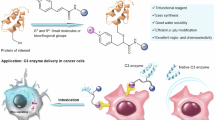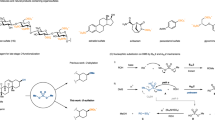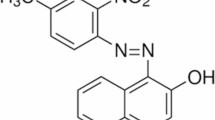Abstract
THE action of diazomethane on proteins has been studied by a number of workers, who report that both O- and N-methylation occur. There is apparently no fission of the peptide chains, although it is stated1 that the action of diazomethane on insulin causes a decrease in the cystine content. On the other hand, Kirst2 claims that the cystine bridges in wool are unaffected by the reagent, and Herzig and Landsteiner3 state that wool is rather more resistant to diazomethane than are other proteins. In most of this earlier work, it was specifically stated that dry proteins and dry ethereal solutions of diazomethane were used. Recently, Kuhn and Ruelius4 have shown that diazomethane acts on aqueous solutions of peptides with formation of the corresponding betaines, while serum albumin and ovalbumin in water are slowly converted to insoluble products. We have now found that wool can be extensively degraded by ethereal diazomethane solutions, the product being almost completely soluble in water. The diazomethane, prepared from nitrosomethylurea, is added to the wool over a period of several days, together with small quantities of water. The soluble product contains no sulphur, and diffuses through ‘Cellophane’, while the appearance of the wool during the reaction closely resembles that of wool treated with strong alkali.
This is a preview of subscription content, access via your institution
Access options
Subscribe to this journal
Receive 51 print issues and online access
$199.00 per year
only $3.90 per issue
Buy this article
- Purchase on SpringerLink
- Instant access to full article PDF
Prices may be subject to local taxes which are calculated during checkout
Similar content being viewed by others
References
Matula, J., Biochem. Z., 300, 284 (1939).
Kirst, W., Melliand Textil. Ber., 28, 169 (1947).
Herzig, J., and Landsteiner, K., Monatsh., 39, 369 (1918).
Kuhn, R., and Ruelius, H. W., Chem. Ber., 85, 38 (1952).
v. Pechmann, H., Ber., 31, 2640 (1898).
Frankel, M., and Katchalski, E., J. Amer. Chem. Soc., 65, 1670 (1943); 66, 763 (1944).
Backer, H. J., and de Boer, T. J., Proc. K. Ned. Akad. Wet., 54B, 191 (1951).
Staudinger, H., and Kupfer, O., Ber., 45, 505 (1912).
Chibnall, A. C., and Rees, M. W., Biochem. J., 48, xlvii (1951).
Head, F. S., J. Text. Inst., 43, T1 (1952).
Author information
Authors and Affiliations
Rights and permissions
About this article
Cite this article
O'DONNELL, I., SWAN, J. Apparent Degradation of Wool by Diazomethane Solutions. Nature 171, 571 (1953). https://doi.org/10.1038/171571a0
Issue date:
DOI: https://doi.org/10.1038/171571a0



